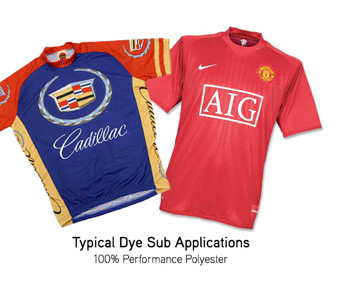One of the fastest growing niches in digital printing is dye-sublimation. Fabric signage, displays, and promotional products are everywhere, and the market is far from saturated.
“We have seen a rise in the number of companies interested in dye-sublimation, and I think a couple of things are driving it. First dye-sub has come fully forward as a process,” says Dan Marx, vice president of Markets & Technologies for SGIA. “To me, this means that the technology is there, and sign and graphics companies fully understand the strong opportunity in dye-sublimation.
“We’re also seeing an expansion beyond printed fabrics and into the many other dye-sub receptive products in the market.”
The door to this opportunity may be wide open, but shops shouldn’t rush in just yet. The dye-sub process can be complicated, and there are quite a few things to consider before purchasing equipment.
Let’s take a look at just what a shop needs to know to break into this market.
Timing is Everything
To determine if the dye-sub market is a fit for them, sign shops should start by examining their customer base. If demand for sublimated products is there—or is a process the shop has had to outsource—it makes sense to enter the market. Dye-sub is also an opportunity to serve clients who are requesting prints with photographic quality because the process offers unlimited color possibilities.
“One of the biggest challenges may be selling a new line of products to customers—both existing or new,” says Marx. “The wide format market today is competitive, so the ability to sell product should always factor into any decision to adopt a new technology.”
Shops should also take a look at the physical space in their shop. In addition to the dye-sublimation printer itself, they will need room for a heat press.
Bringing the entire process in-house may not be an option for everyone, and a shop can choose to align with a local provider. They can also opt to start with a smaller machine and experiment.
“Dye-sub equipment offerings lends itself to a very broad range of sizes, applications, and entry costs,” says Randy Andersen, product marketing manager for Mutoh. “This allows many customers to test the market with a low entry cost. Many will start with a small printer and add additional units of the same model to increase output and provide some redundancy.”

All the Right Tools
Once a shop enters the dye-sub market, printer size isn’t the only equipment decision they have to make. They must also decide if they want a printer that prints directly to fabric or employs a transfer paper process.
Choosing whether to attach the sublimation process to the printer is another consideration. It may appear that attaching the heat press will make things easier, but it can actually make the entire process more difficult because separate settings for the printer and the press are no longer possible.
“If you’ve got an in-line sublimation process, that means you need to develop the in-line sublimation settings for each one of these speed settings [on the digital printer] for each one of the materials that you print on,” says Mike Wozny, strategic product manager for EFI. “It becomes very complex, as compared to having the same sublimation settings independent of print speed.”
It’s also important to choose a quality heat press. “Having a good heat press where the heat and the temperature is even and constant throughout the platens/fabric will see that your output is good every time,” says Catalina Frank, product manager for the F-series of Epson Professional Imaging.
Beyond the printer and press, software and consumables (transfer paper, ink, sublimatable media, etc.) are necessary. Some finishing equipment may also be required depending on the application.
In fact, Dan Barefoot, president of Graphics One, recommends shops focus in on one application in the beginning before moving into other dye-sublimation venues so that they know what they need.
“As in large format imaging, there are so many different types of sublimation—whether it be for apparel, hard goods, soft signage, or promos,” he says.
Barefoot also offers some tips for how shops can properly maintain their equipment and materials:
+ “Prepare the environment prior to printer installation. Humidity above 25 percent and below 80 percent is preferable.”
+ “Performing regular maintenance will help keep your printer running in tip-top condition. Clean the wiper and cap assembly once a week with cleaning solution.”
+ “Make sure your paper can hold the amount of ink you need. Too much ink is not the same as good color.”
Above all, when purchasing equipment, shops need to be sure they are partnering with a provider who can offer them the support they will need—on both products and process.
The More You Know
Support is essential because the learning curve of dye-sub can be steep. “The expertise is probably the most significant barrier to market on this; that’s what keeps a lot of people out,” says Wozny.
For this reason, a shop should start arming itself with knowledge right from the outset.
“Printers must spend the time studying what they can and cannot print on or transfer to before they start purchasing equipment,” says Dave Conrad, marketing manager at Mutoh. “An educated print shop owner will be able to make better decisions on how to get into the market and grow his or her business more quickly than if they do not take the time to learn the market.”
One of the largest contributions to the learning curve is the enhanced profiling required for the dye-sub process.
“With UV printing, you have one output profile, maybe two, for hundreds of different materials. Whereas with dye-sub it takes a little more upfront work,” says Wozny. “There’s just a very wide range of materials that are out there. And you need the profile for each material to have the proper settings.
“So the guys that are truly optimized on quality that produce a very high-quality print are the ones that have a specific profile or environment for every application and every material.”

This is why it’s important to find a supportive provider who can supply basic color profiles and information to get started. For example, Barefoot cautions that when building a profile, for accurate results, users must measure the color on the transferred media, not the dye-sub paper.
Frank further explains why this distinction is important. “What you print on your transfer paper is not the same as what you see after it’s heat-pressed onto the fabric,” she says. “What you’re looking at after you press, that is the final output. And sometimes the paper will look washed out and have banding, but after it’s put on the fabric, it looks absolutely perfect and vibrant.”
The media side of dye-sub is much simpler—the fabrics must be polyester or polyester-coated. And the higher the percentage of polyester, the more vibrant the image.
Fortunately today’s polyester is nothing like the pantsuits of yesteryear. “Many new types of weave and finish give polyester the look and feel of soft quality cotton,” says Andersen.
Conrad adds that the equipment is making it ever easier to produce high-quality images either directly onto fabric or transferred to material. “So the pace at which new substrates become available will continue to grow,” he says.
Frank warns, however, that shrinkage can occur when transferring an image to polyester. “Because it’s polyester-based, some of the fabrics shrink more than others when you’re heat pressing and this could cause ghosting,” she says, then offering a solution to this problem. “Pre-heat or pre-shrink this polyester fabric at the press. When you apply the paper onto the fabric, then your substrate is pre-shrunk and it doesn’t cause that ghosted image on the output.”
Frank goes on to say that the transfer paper quality is as important as the material. “If you’re using the right transfer paper for your application, you’re transferring the better part of the ink that you need for a better color,” she says. “If you’re using bond paper for transfer, you’re leaving all your ink money on the paper and not really transferring all the color to the substrate.”
Stepping into Digital
Entering the dye-sub market can be an entirely new experience for screenprinters, who are often also crossing into the digital realm for the first time.
“Going digital is the first concern of screenprinters who have previously been using analog methods,” says Barefoot. “The major difference is that a screenprinter can image a one-off shirt digitally, but to break even with traditional methods, one may need to produce 100 to 200 garments.”
While going digital allows for smaller runs and customization, it also cuts down on turnaround times because there are fewer steps. However this can be a mixed blessing for former screenprinters.
“When you start getting into digital, customers want it that same day,” says Wozny. “It’s a different workflow when you’ve got to turn something around the same day rather than having a week to produce it.”
Despite the growing pains, learning curves, and equipment requirements, dye-sublimation printing can provide an impressive ROI and a profitable niche to break into for many shops and screenprinters.
“It’s a huge growth opportunity,” says Wozny. “We see it as just a good market to be in.”











